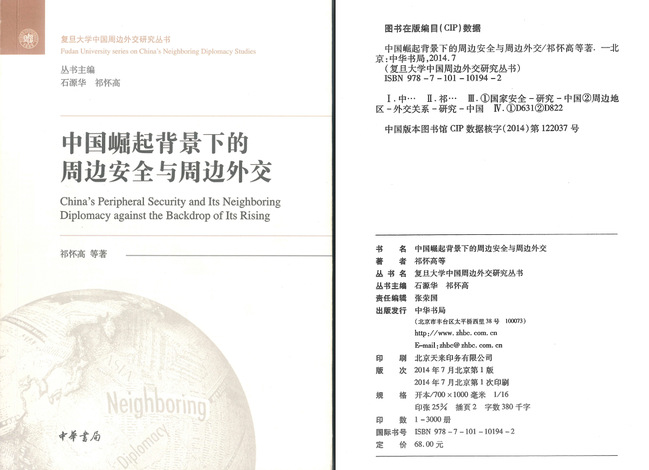QI Huaigao, WU Lin, HE Ping, LIU Fenghua, YANG Xiaoping, LOU Chunhao, MA Bin, JIANG Yingmei, and XU Xiujun, China’s Peripheral Security and Its Neighboring Diplomacy against the Backdrop of Its Rising, Beijing: Zhonghua Book Company, July 2014. (in Chinese)
ISBN: 978-7-101-10194-2

The title page of China’s Peripheral Security and Its Neighboring Diplomacy against the Backdrop of Its Rising | The copyright page of China’s Peripheral Security and Its Neighboring Diplomacy against the Backdrop of Its Rising |
The book, China’s Peripheral Security and Its Neighboring Diplomacy against the Backdrop of Its Rising, in its 12 chapters divided into three parts, mainly studies the peripheral security challenges China faces and its neighboring diplomatic strategies to cope with them against the backdrop of its rising. The authors argue that China needs to distill from its diplomatic practices a forward-looking “pan-peripheral diplomatic strategy,” which includes the following five elements: Firstly, China needs to reinforce the “pan-peripheral diplomatic idea” as a support for the spread of China’s “strategic frontier.” Secondly, China needs to develop the “new type of great power relationship” with the U.S., Japan, Russia and India. Thirdly, China needs to extend its diplomatic endeavors to six sub-regions, which include Northeast Asia, Southeast Asia, South Asia, Central Asia, Western Asia, and South Pacific. Fourthly, China needs to coordinate China’s borderland development and China’s neighboring diplomacy in the situation of overall planning of China’s domestic and international situations. Lastly, China’s new national security commission will take the leading role to incorporate four major diplomatic approaches, namely “breaking through from the sea”, “approaching Central Asia and Middle East,” “reforming domestic diplomatic institutions,” and “extending to Latin America and Africa.”
Authors/Contributors
QI Huaigao is Associate Professor at the Institute of International Studies, Fudan University.
WU Lin is Assistant Professor at the Institute of Asian Studies, China Foreign Affairs University.
HE Ping is Associate Professor at the Institute of International Studies, Fudan University.
LIU Fenghua is Research Professor of the Institute of Russian, Eastern European & Central Asian Studies, Chinese Academy of Social Sciences.
YANG Xiaoping is Assistant Research Professor at the National Institute of International Strategy, Chinese Academy of Social Sciences.
LOU Chunhao is Associate Research Professor at the Institute of Maritime Strategy Studies, China Institutes of Contemporary International Relations.
MA Bin is Assistant Professor at the Institute of International Studies, Fudan University.
JIANG Yingmei is Associate Research Professor at the Institute of West-Asian and African Studies, Chinese Academy of Social Sciences.
XU Xiujun is Associate Research Professor at the Institute of World Economics and Politics, Chinese Academy of Social Sciences.
Contents
Series Editor’s Preface……1
List of Figures and Tables……1
Introduction……3
Part One: An overview of China’s peripheral security environment and its neighboring diplomacy……25
Chapter One: Changes of China’s peripheral security environment and evolution of China’s neighboring diplomatic policy during the post-Cold War period……27
Chapter Two: New peripheral security challenges faced by China and new neighboring diplomatic strategies adopted by China in the second decade of the 21st Century……52
Part Two: An analysis of the great power factors in China’s neighboring diplomacy……89
Chapter Three: China-U.S. relations: contending and compatibility in Asia……91
Chapter Four: China-Japan relations: rivalry and coexistence in Asia……115
Chapter Five: China-Russia relations: cooperation and competition in Asia……142
Chapter Six: China-India relations: co-emergence and balance in Asia……171
Part Three: A study of China’s peripheral security and neighboring diplomacy in the six sub-regions of Asia……197
Chapter Seven: The Changing Northeast Asian security environment and China’s diplomacy toward the NEA……199
Chapter Eight: The Changing Southeast Asian security environment and China’s diplomacy toward the SEA……227
Chapter Nine: The Changing South Asian security environment and China’s diplomacy toward the SA……253
Chapter Ten: The Changing Central Asian security environment and China’s diplomacy toward the CA……281
Chapter Eleven: The Changing Western Asian security environment and China’s diplomacy toward the WA……304
Chapter Twelve: The Changing South Pacific security environment and China’s diplomacy toward the SP……335
Conclusion: Constructing China’s “Pan-Peripheral Diplomatic Strategy” in the next decade……363
Appendix: Survey of China and its neighboring countries……368
Bibliography……376
Postscript and Acknowledgements……397
The publication of China’s Peripheral Security and Its Neighboring Diplomacy against the Backdrop of Its Rising was made possible through a generous grant from China National Social Science Foundation and Asia Research Center of Fudan University.
The Book, China’s Peripheral Security and Its Neighboring Diplomacy against the Backdrop of Its Rising, is the 1st book in Fudan University Series on China’s Neighboring Diplomacy Studies.
Fudan University Series on China’s Neighboring Diplomacy Studies is the publication project supported by the Center for China’s Relations with Neighboring Countries of Fudan University (CCRNC Fudan).






